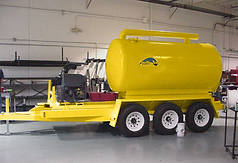
VACUUM EXCAVATORS
Pacific Tek Power Vac™ Vacuum Excavators are manufactured for potholing/daylighting “vacuum excavation.” Every Pacific Tek Vacuum Excavator can non-destructively find utility lines and pipelines, clean out catch basins, and work with Pacific Tek Valve Exercisers. To aid in digging, water or air is used under low pressure to loosen up the dirt so that the Vacuum Excavator can vacuum the dirt into the Vacuum Excavator’s debris tank.
These units are offered as a skid mounted vacuum or can be built onto a flatbed or trailer. Pacific Tek offers eight basic tank sizes with over 100 different configurations and options, depending on the customer's needs. The larger tanks have a reverse flow option where, at the flip of a lever, flow is reversed in the system which allows you to either pump liquid or slurry out of the tank to a higher place, or, to free up clogging in the pickup hose by having air blow the reverse direction.
Vacuum Excavators Used For:
Vacuum Excavator Models:
-
POTHOLING
-
DAYLIGHTING EXCAVATION
-
CLEAN UP HDD DRILLING MUD
-
KEYHOLING
-
DEBRIS/MUD REMOVAL
-
STREET REPAIR
-
GREASE TRAP CLEAN-OUT
-
GOLF COURSE MAINTENANCE
-
CAR WASH SUMP/PIT CLEAN-OUT
Vacuum Excavation, also known as "Potholing" or "Daylighting" is the process of using vacuum and sometimes an assisting process such as high pressure water jetting and high velocity air jetting to “suck” a hole in the ground. The hole size can be from 4 to 12 inches in diameter and can be from 1 to 20 feet deep. This process replaces manual or machine digging when there is the possibility of damage to anything in the underground vicinity of the area being uncovered.
With the number of utilities being run underground and the use of plastic pipe and conduit instead of heavier steel the risk of damage once a line is found by either a shovel or a backhoe is greatly increased. Vacuum excavation greatly reduces this risk and is referred to as a “non-destructive” digging method. Once on top of a line or cable the vacuum tube simply cannot continue down and the line being sought is safely found. This process is being used by gas companies, water and wastewater utilities, telephone companies, and underground contractors doing work for all of the above.
Vacuum excavation began with the use of large vacuum trucks, originally designed for sewer cleaning but which could be adapted for digging. Exactly when this began I’m not sure but it has been at least 25 years ago. These trucks were large and very costly but at the time they were all that was available. The interest in the process of vacuum excavation was not what it is today because at the time there were not as many delicate underground utilities such as fiber-optic cable and small plastic lines that we now have. Since that time several companies introduced smaller, cheaper, but equally powerful machines to do this work. Not only were they more affordable, they could get into tighter spaces, could be operated with minimal training by normal work crews, and were generally better suited for this work.
The large sewer cleaning trucks relied on the combination of high pressure water jetting to turn ground into a slurry that was then sucked into a tank. It could never be immediately re-used as back-fill. It had to be hauled off and new fill hauled in to fill the hole.
Today’s smaller vacuum excavators can work dry in almost anything but clay or very hard soils. The larger units can incorporate their own water and air jetting systems and some even have multiple debris tanks for storing wet or dry debris separately.
The increased uses of directional boring machines to tunnel from point “A” to point “B” instead of open trench digging to lay lines greatly helped the development of the vacuum excavators. The process of directional boring produced a slurry of Bentonite and water which had to be sucked from the boring machines launching pit before it overflowed and ran into storm sewers or down a city curb. Vacuum systems to recover the drilling mud were not required to have the horsepower necessary to “dig” but merely to slurp up the slurry.
When accidental piercing of underground lines by the directional drills started to occur because the line was not where it was indicated to be the drillers started to uncover lines to confirm their presence and depth before drilling. This is where vacuum excavators came in handy. The holes only had to be large enough to see the line or cable. About 25 years ago vacuum systems were introduced for the municipal water departments to clean out underground gate valve boxes and meter boxes. These were also less powerful than today’s machines and could not dig a hole. The utility departments also asked for more powerful machines so that they could be used to relocate a valve box or excavate down to find lines where work was to be done.








